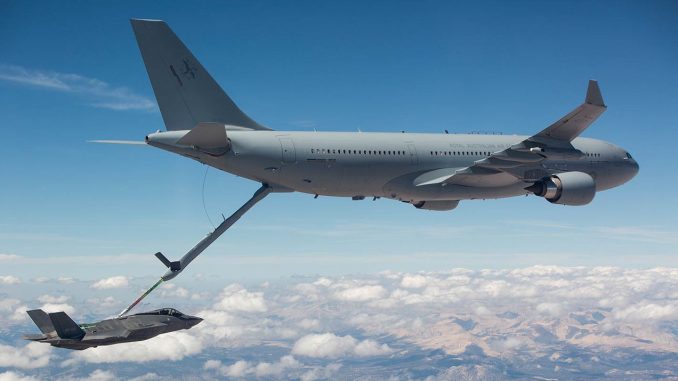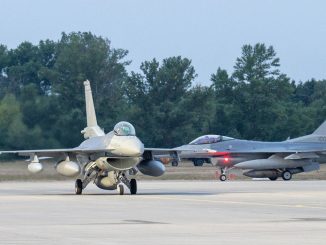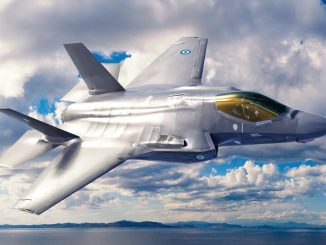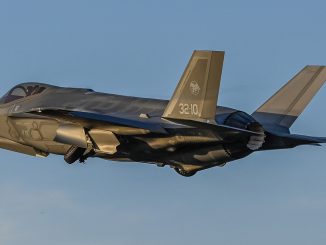
Here’s why leaving the Shared Air Refueling Capacity was probably not a good idea.
The first A330 MRTT platform for the MMF (Multinational MRTT Fleet) has been delivered. It may serve as an inspiration to reflect on the Polish involvement in the initiative.
Poland, originally, was to be a part of the program, however, it resigned from participation back in 2016. According to General Tomasz Drewniak, former Air Force Inspector, interviewed by Gazeta.pl’s Maciek Kucharczyk, never did the leadership at the MoD provide the Air Force with reasoning, as to why Poland would resign from the program. The decision was made just three days before the agreement signing date, back in 2016, being a surprise to the generals.
According to czdefence.com, for now, six allied countries are bound to become a part of a joint program aimed at using a common fleet of A330 tankers. The shared fleet would be operated in a manner similar to that applicable to the NATO SALIS solution. The joint squadron is to provide a pan-European air-refueling capacity for the air forces that lack assets or budget to obtain this option. Europe lacks in this domain, and frequently the USAF assets are used instead. The Polish Air Force, for instance, currently conducts air refueling training in the Polish airspace with both USAF KC-135 (flying from RAF Mildenhall) or with the Dutch KDC-10 tanker. This is done without any agreements or any program framework, just as a part of allied interoperability efforts. No specific documents have been signed within that regard. It is more of a gentlemen’s agreement, General Tomasz Drewniak told Kucharczyk.
The MMF idea dates back to 2012, when 10 European nations (Belgium, France, Greece, Spain, Hungary, Luxembourg, the Netherlands, Poland, Portugal, and Norway) decided, on Nov. 19. 2012, to sign a letter of intent. The program was supervised by the EDA (European Defence Agency). In December 2014 it was announced that the Netherlands, Poland, and Norway began negotiation with Airbus, on joint acquisition of the A330 MRTT aircraft. Also, a decision was made to route the procurement via NATO NSPA (NATO Support Agency) that delegated the work to OCCAR (Organisation Conjointe de Coopération en matière d’ARmement). Back then it was estimated that Poland would need to contribute 22 percent of the overall costs.
Luxembourg and the Netherlands ultimately became the first nations to decide to acquire the tankers, with the Ducth becoming the leaders of the program. Nonetheless, the tankers would become NATO property (similarly as in the case of the E-3A component based in Geilenkirchen, Germany). They are, however, available to both Luxembourg, as well as the Netherlands, as necessary, also in the air transport role. The fleet is based in Eindhoven.
Even though a Memorandum of Understanding has been signed by and between the Netherlands and Luxembourg, the MFF program remained open for other nations. As a result, the MRTT program is now pursued by six European nations Belgium, Germany, Norway, the Netherlands, Luxembourg, and the Czech Republic. The cost is shared proportionally to the level of use of the assets. Back in 2014, the reports suggested that up to 8 tanker aircraft could form the fleet (maximum capacity of the airbase in Eindhoven).
Originally, as we reported, Poland was also expected to be in that group, as one of the leading nations. Analytical efforts within that scope were still going on back in 2016. The decision that the Netherlands and Luxembourg would procure two Airbus MRTT aircraft for the MMF (Multinational MRTT Fleet) was announced on Jul. 28, 2016. Back then, the MoD claimed to be still analyzing the initiative options. The MoD was scrutinizing the matter within the scope of finances, claiming that it would be more beneficial to allocate the funds to the modernization of the Polish military. The Polish MoD also negotiated industrial return conditions (offset) with Airbus Defence & Space, within the scope of the deal. Back in 2016 one of the arguments against the involvement in the program stemmed from the cost – it was estimated that 1,165.4M Zlotys (about 265M Euro at the EUR-PLN currency exchange rate on Jun. 6. 2016) would need to be allocated to the program by 2022. The MoD claimed that spending as such could have a detrimental impact on the modernization of the military. Offset was to be another side of the equation. It needs to be said, however, that identical reasoning was adopted in case of the tanked Caracal helicopter deal. According to Maciek Kucharczyk’s report, Poland was to play an important role in the initiative, establishing a forward operating base for the tankers in Powidz.
Currently, Poland is not willing to get involved, as Warsaw is declaring that it would procure its tankers. The reasoning behind that stems from the reportedly inadequate offset offered by the manufacturer. Ultimately, the MoD started to analyze the MRTT capability options on Feb. 15, 2017, when the Armament Inspectorate of the Polish MoD decided to begin a market analysis on the potential acquisition of the MRTT platform (Karkonosze program). According to the available information, the analytical effort is still underway, without any symptoms of the process coming to an end.
The decision is difficult to comprehend, as it significantly weakens the Polish Air Force’s potential. The F-16 and the future F-35 fleets will be unable to utilize their combat potential to the fullest.
What’s interesting here, is the Czech data on the program. The operation, according to czdefence.com, for the Czech Republic, would entail a price tag of 1.9 billion CZK (80 million US dollars), over a cycle of 30 years. The Czech would receive 100 flight hours/year. The division of flight hours, according to czdefence.com, per year, is to be as follows: Germany – 5,500 hours, the Netherlands – 2,000 hours, Belgium – 1,000 hours, Luxembourg – 200 hours, Norway – 100 hours, the Czech Republic – 100 hours. The cost seems to be insignificant. Even if Poland was using 10 times more hours, the cost would be placed at the level of around PLN 3 billion (671M Euro) over 3 decades, translating into PLN 100 million per year (22.3M Euro). This price tag is insignificant when placed on the background of the annual defense budget of Poland as a whole (e.g., the planned FY2020 defense budget is defined as ca. PLN 50 billion, ca. 11.1 billion Euro). This makes it even more difficult to understand the reasoning behind the Polish withdrawal. Similar statements are made among the industry experts. Our source in Airbus told us, off the record, that it is very difficult to understand the decision, given the time and effort investment that Warsaw already made within that regard. The problem is not associated with the cost or availability either. IAI was marketing its offer to convert B767 to a tanker, jointly with the Polish WZL-2 facility. Without any tangible results. The same can be said about the Boeing’s marketing effort concerning the KC-46. Clearly, the stoppage here stems from the lack of will, not lack of available options.
The aerial refuelers act as force multipliers. Not only are they useful for offensive sorties but they are also useful in defensive context, with the fighters staying in the air when conducting the policing duties. General Drewniak, as cited by Kucharczyk, stated that using just 30% of the assets is possible without the tankers, with an ability to employ almost 70%, should tankers be available – one jet is on the ground, one is en route to the CAP area, and one is in the AoR. With the tankers, there would be no need so urgent, to rotate the jets, as the fuel could be provided without them returning to base. The tankers also make it challenging for the enemy to analyze the air picture, as there is no clear possibility to assess how long the jets would stay in the air. If no tanker is present, then the time that the fighter can remain in the air is determined by the quantity of fuel that is carried – and this value is usually well known. The tankers, hence, introduce an element of uncertainty in the operational scenarios.
Instead of the MRTTs, the Polish MoD procured G550 and B737 VIP transport aircraft. These single-purpose assets limit the array of capabilities available to the Air Force. As the British example has shown, the MRTT cabin could be rearranged to accommodate VIP transport or MEDEVAC sorties. In the case of the single-use VIP cabin arrangements, the multi-purpose character of the platform seems to be lost. It is difficult to find the reasoning behind the course of events described above.



